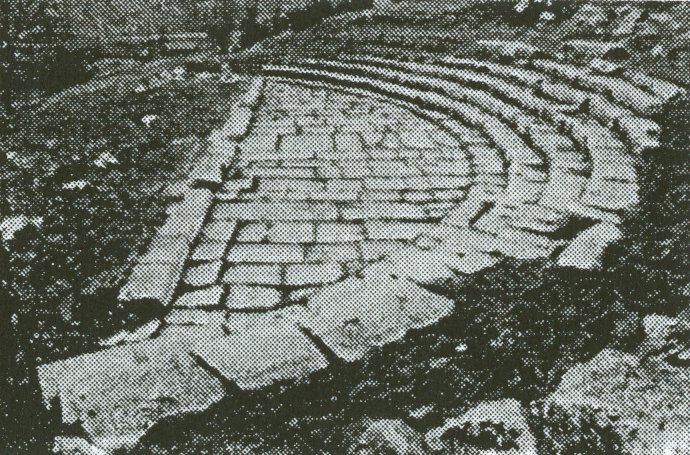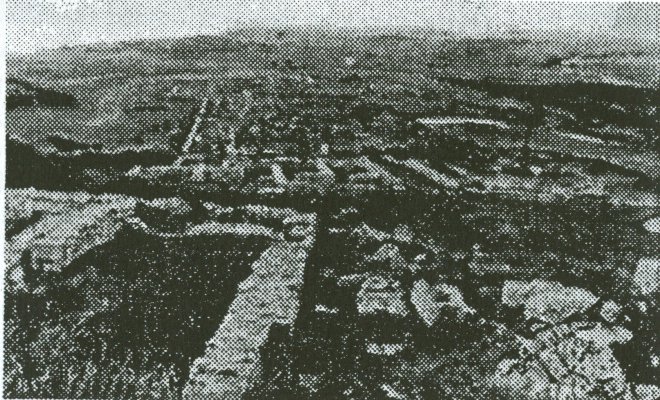By Elio Moschetta
The pantomime of the excavations at
 Juvanum has lasted for over half a
century, but it has only attracted the attention of specialists in recent years,
whilst that of the THIEVES has lasted forever. Amongst Roman colonies Juvanum
must have been the main point for the arrival and distribution of imported
goods. Luxury objects, silk, spices and ivory must have arrived from the Orient.
Around the Samnite town deposits of building materials multiplied and the brick
ovens testify to this. Money held its buying power; it was possible to live on
the "plain" with just one brass Sesterzio coin, the equivalent in those
days of two bronze Assi coins. We have before us, or so it seems to us, a
new model of defence launched by Augustus. Juvanum strengthened the military
capacity of Rome for the military authorities. The basis of this was a military
contingent of reduced size, but so efficient and speedy, that it was able to
move itself rapidly to the most vulnerable frontiers of the empire. Amongst the
most improved campaign methods there must have been CATAPULTS. The arms of an
individual soldier, other than a short sword, double edged sword (gladio)
and a PILUM (weighted javelin), consisted of a "giavellotto" (light
javelin) and also a HASTA (thrusting spear) of composite materials.
The engineer, in every legion, had at his disposition specialists in war
constructions, capable of designing canals, fortifications, roads and squares.
At the end of the Second World War, near Juvanum building equipment was found,
for example a DOLABRA (mattock or pickaxe), a type of pickaxe; not by
chance did Corbulone (a General under Nero) love to repeat that victory
was won even "with a colabra". The ancient fountain and remains of lead and
ceramic water pipes show that Juvanum could have offered thermal cures using
cold water, that is the use of hydrotherapy to remove ailments of the liver.
Juvanum has lasted for over half a
century, but it has only attracted the attention of specialists in recent years,
whilst that of the THIEVES has lasted forever. Amongst Roman colonies Juvanum
must have been the main point for the arrival and distribution of imported
goods. Luxury objects, silk, spices and ivory must have arrived from the Orient.
Around the Samnite town deposits of building materials multiplied and the brick
ovens testify to this. Money held its buying power; it was possible to live on
the "plain" with just one brass Sesterzio coin, the equivalent in those
days of two bronze Assi coins. We have before us, or so it seems to us, a
new model of defence launched by Augustus. Juvanum strengthened the military
capacity of Rome for the military authorities. The basis of this was a military
contingent of reduced size, but so efficient and speedy, that it was able to
move itself rapidly to the most vulnerable frontiers of the empire. Amongst the
most improved campaign methods there must have been CATAPULTS. The arms of an
individual soldier, other than a short sword, double edged sword (gladio)
and a PILUM (weighted javelin), consisted of a "giavellotto" (light
javelin) and also a HASTA (thrusting spear) of composite materials.
The engineer, in every legion, had at his disposition specialists in war
constructions, capable of designing canals, fortifications, roads and squares.
At the end of the Second World War, near Juvanum building equipment was found,
for example a DOLABRA (mattock or pickaxe), a type of pickaxe; not by
chance did Corbulone (a General under Nero) love to repeat that victory
was won even "with a colabra". The ancient fountain and remains of lead and
ceramic water pipes show that Juvanum could have offered thermal cures using
cold water, that is the use of hydrotherapy to remove ailments of the liver.
'Aclepiade' (Asclepius) administered to the emperor a "mithridate" (small doses of poison to build up immunity) that cures dozens of illnesses. The Romans, however, trusted traditional medicines for centuries. Thus every PATER FAMILIAS (father of a family) could treat his own family and, why not, also his slaves.
Doctors who treat the lower classes come from the Greek school in their MEDICATRINA (clinic/hospital), and we know that doctors in ancient Rome were favoured by Augustus. Every legion has a MEDICUS LEGIONIS (Doctor of the Legion) and for lengthy confinements to bed there was the VALETUDINARIUM IN CASTRIS, a large military field hospital. According to A. Madonna, (local archeologist) various surgical instruments have been found in Juvanum, such as SCALPRI (scalpels), SPECULI (speculae) and UNCI (hooks). Maybe the Romans even reached China whilst searching for ivory and other luxury goods for which the patricians would have paid a fortune.
L’OPUS CAEMENTICUM, (cement work) a mixture of mortar and crushed stone, constituted the nucleus of the walls at Juvanum, which then were covered with bricks. The vaults of the basilicas must have been cemented with mortars. Water from the spring, known until last year as the Madonna’s Spring, (FONTANA DELLA MADONNA), was used not only for mixing (the cement) and for the building trade in general, but also for domestic use. Appropriate water pipes carried the water into the houses, and to maintain the constant downwards slope of the sections on level ground there were raised conduits secured by arches. In the baths of the CALIDARIUM (hot bath) the water could be heated by means of the IPOCAUSTI (hypocausts), empty spaces found under the pavements at Juvanum.
If every inhabitant of Rome had at their disposition a thousand litres of water a day, at Juvanum the range of the FONTANILE (fountain/spring) provided almost the same quantity. Juvanum wanted to revive the ancient cults and restore the religion and the Gods of Ancient Rome, but we do not know for certain either the name of the sacred centre, or which divinity was honoured there.
Archeologically it is documented that on the hill of the Roman City, is the
crossroads of the valley bottom route linking the Aventino and Sangro rivers,
and the mountain route joining Torricella Peligna to Montenerodomo. Construction
of the theatre on the eastern slopes of the hillside, enclosed by the
surrounding wall, accentuated the importance of Juvanum’ s sanctuary. The
orchestra pit, in parallel rows, is still in good condition today, although the
various levels of seating and steps are in great disorder.
s sanctuary. The
orchestra pit, in parallel rows, is still in good condition today, although the
various levels of seating and steps are in great disorder.
The entire complex of the monuments of the city and the apse room, seat of the cult dedicated to the Imperial Household (AUGUSTALES), denote the availability of ample funds, as various inscriptions show for its restoration. The discovery of china, glass and personal luxury ornaments testify to the personal wealth of the inhabitants of Juvanum, but due to the "disaggregation"/scattering of data, it is not possible to proceed to typing the objects, that is to give them a "market value" or a cultural value for each single finding.
With all probability we can conclude that Juvanum, even before the temples were built, was a place of CULT, maybe dedicated to WATER. Later a Pagan God ruled in the temple. (A person named) Bayer proposes the presence of a sanctuary to HERCULES, like in other Samnite centres. We have before us a complex picture of a "scene" which constitutes one of the most fundamental forces created in the story of the city: MYTH.
Certainly, that which we are told is not historical truth; it is a truth of another nature, which we can define as PARAHISTORY. Its stimulating effects on the thoughts of the Romans, avid consumers of myths, seem to have been as significant as those of their history, of which they were so proud. Hercules became a very popular God and he has been identified in all Mediterranean countries.
This is the reason why many variations and new adventures were added to his myth. There is no epic poem that narrates his deeds, but he is a very important person in many tragedies. Amongst the Etruscans he was known as ERCLE and he was considered to be one of the Gods of war and of WATER.
©
Amici di TorricellaTranslation courtesy of Dr. Marion Apley Porreca